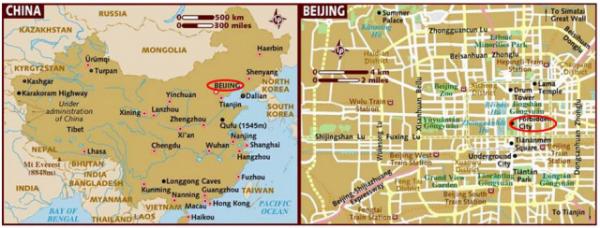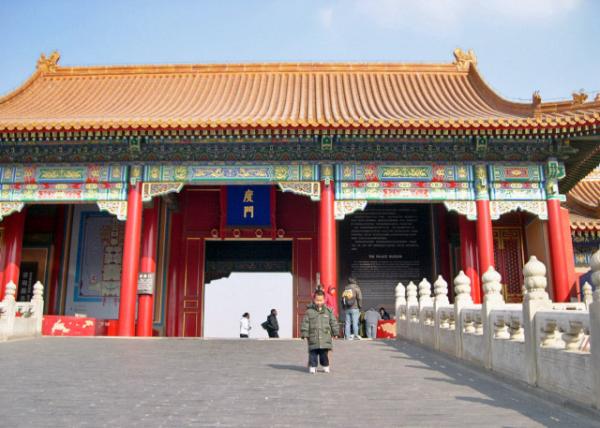| Forbidden City of Beijing(北京紫禁城) |
| 送交者: 天邊的紅霞 2020年05月07日06:58:23 於 [五 味 齋] 發送悄悄話 |
|
2015-08-21
【Aiden in English】 Beijing used to have good weather all year around. Nowadays, I don’t think so. But the point is that it had warm summers and fair winters. A water source was extremely close by, which made a wonderful place for the rulers of China when you would consider all these factors. The Forbidden City is not so “forbidden” anymore. It’s actually quite the opposite. The name, well, was given because ordinary peasants used to be forbidden back then. Yet today, it’s amazing what ten US dollars can get you into. Because of the good weather and geography, Beijing was home to Emperors of 24 generations from Ming to Qing Dynasties and is the capital of the People’s Republic of China with about 22 million in population. Wherever I travel around the world, all capitals contain the same message. “I’m the ruler of this nation. So I will live in a big house by myself and nobody may enter!” It sounds very familiar to other places, don’t you think? The Forbidden City wasn’t an actual city, but it might as well have been in the old days. An emperor always needed his style and a feeling of supremacy. The Forbidden City has a huge entrance, with double doors of Meridian Gate made of metal with studs arranged in rows jutting out for defense and intimidating factors. They provided no foot or handholds to scale it. But inside was the whole other story. The walls that surrounded the city were large, too. I must say, even after a visit to Rome, I’m impressed by the architecture. There really isn’t anything quite like the CityCenter of Beijing. Enormous rectangular buildings with stunning roofs in Hip and Hip-and-Gable styles loomed over the courtyard. The roof had bamboo-like glazed tiles that infused it with texture, and also puzzled outcroppings holding up to the outer edge of the roofs. Dragons are extremely important in Chinese history, and it would only make sense that on these buildings. Dragons were carved into the stone, mahogany, and jade, acting as the decoration and border to empty areas. Dragon patterns were painted to symbolize an emperor as the son of Heaven in three main halls: Supreme Harmony, Central Harmony, and Preserved Purity. On the other hand, the Chinese build the most colorful structures in the world. Vivid red walls, yellow tiles, gold carvings, and white marbles flashed in your eyes every time you took a glance at something. If that wasn’t enough, a contrast would be added on the pediments, ridge roofs, girders, angle modillions, and marble pillars. But the Forbidden City wasn’t done yet. Stretching onwards from both sides of the city was a small maze of houses that were built for an emperor for his daily services. He would eat, sleep, talk, consider, and negotiate, etc., in a different house every time, each house with gorgeous decoration and priceless artifacts. In many windows, people could see a detailed tapestry, each weave down to a hair width. The corridors went on wrapping around one another for so long, which felt surreal. After all, it was a City Center. But I think everyone who is reading this gets the points that the ancient Chinese were creative and emperors liked to show off. Whether it is to intimidate, boast, or simple just to “wow” people, the Chinese emperors did all of the above. Rome now just might have some competition. 【紅霞譯文】 從前北京一年四季氣候適宜,如今,我反倒認為未必如此,但有一點毋容置疑,那就是夏涼冬暖水源充足,可以說天時地利,難怪被當時中國統治階層視為風水寶地。 紫禁城不再是一個“禁城”,字面意思與實際含義早已相去甚遠,其名稱原指嚴禁平民百姓入內,如今只要肯花$10塊大洋,隨你自由進出。北京氣候條件良好,地理環境適中,曾是明清兩個朝代廿四位皇帝寢宮所在地,如今作為中華人民共和國的首都,大約二千二百萬同胞在這裡生活。每當我周遊列國,愈發感覺各國首腦無不競相昭布於世,“我掌管國家大權,有資格獨居豪宅,閒人止步!”聽起來多麼耳熟,對不對? 紫禁城其實算不上一個城,也許在當時別具規模。皇帝自有皇帝的份兒,無時無刻都想表現高人一等。紫禁城入口很大,第一道午門是金屬制的雙開門,上面有成排向外凸出的釘子,起到防衛與恐嚇作用。與大門內側不同,外側未設任何扶手及落腳的東西;城牆特別厚實,把整個故宮圍得嚴嚴實實。剛從羅馬鑑賞雄偉奇觀歸來,我依然深為紫禁城所折服。說真的,無論走遍世界,我都難以看到像北京這座城中城如此輝煌壯麗的古代建築群。 皇城庭院上,廡殿頂與歇山頂等巨大長方形宮殿錯落有致;房蓋琉璃瓦片呈質感性強的竹片狀,並點綴不同寓意的裝飾圖案,要麼象徵吉祥富足,要麼表現高貴威嚴。龍為中國神話的百麟之長,可謂傳承中華民族精神的圖騰標誌,因此以龍為背景的木雕石刻玉器屢見不鮮,太和殿、中和殿和保和殿三大殿內飾有大量金龍和璽彩畫,索性把人間皇帝當作真龍天子。此外,中式樓閣亭榭等建築特別講究色彩艷麗,黃瓦、紅牆、金飾、白石交相呼應,彰顯中國古代宮廷藝術特徵;山花、屋脊、梁枋、檐角、華表上各種鎏金銅葉龍鳳瑞獸,更加強烈地營造出富麗堂皇的視覺效果。紫禁城之美遠遠不止這些,如果沿中軸線向兩邊展開,那麼你會發現形形色色猶如置身迷宮的朝房廊廡,這是皇帝日常出沒的地方,吃飯睡覺聊天思考會客等各項事宜分別選在專設的地點進行,而每處裝璜精工細作,擺設用具極其考究。遊客們可以近觀掛毯製品,手工細膩到頭髮絲那麼細。故宮御道連亙通幽,簡直不可思議。至此我幡然醒悟,紫禁城是一個地地道道的“城中城”,恐怕跟我一起同游的讀者也清楚地認識到古代中國人巧奪天工,帝王將相們又熱衷炫耀自己的豐功偉績。 無論是為了敲山震虎,還是炫耀地位,或是取悅世人,中國歷代皇帝不惜勞民傷財。由此說來,羅馬需要加把勁才能迎頭趕上。
|
|
|
|
|
 |
 |
| 實用資訊 | |
|
|
|
|
| 一周點擊熱帖 | 更多>> |
|
|
|
| 一周回復熱帖 |
|
|
|
|
| 歷史上的今天:回復熱帖 |
| 2019: | 有人要哭了。 | |
| 2019: | 如果川普周五真的提升關稅到25%。 那香 | |
| 2018: | 呵呵。拋個書包,“硅”字諗啥? | |
| 2018: | 北大校長念白字,好像不是那麼簡單的事 | |
| 2017: | 海黃生活賽天朝 | |
| 2017: | 說個屁啊。空氣流過彈頭表面會升溫還是 | |
| 2016: | Marx Was Right: Five Surprisin | |
| 2016: | 四十歲遇到二十歲那年的初戀 | |
| 2015: | 和老巫談談詩詞的韻律問題 | |
| 2015: | 說法語在這裡太小眾,推薦一篇科普英文 | |







